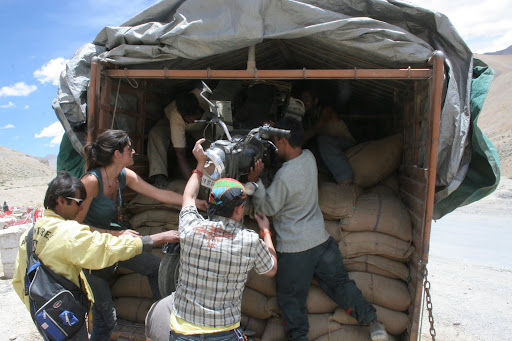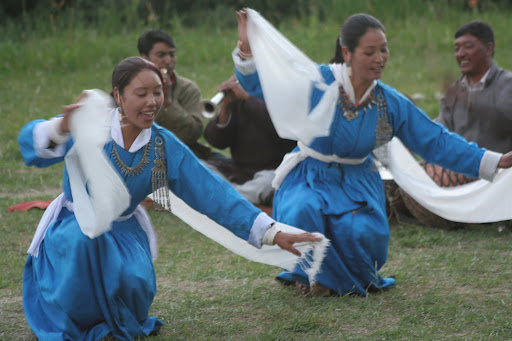The morning begins with Rc’s concoction kicking in, and living up to full expectations and well beyond. Never felt so clean from within, light as a feather, floating on air.
 Do a quick visit down to Sarchu gorge in the morning while the rest of the public is getting ready; the gorge is lined with fantastical rock pillars, carved by rain or snow into the river.
Do a quick visit down to Sarchu gorge in the morning while the rest of the public is getting ready; the gorge is lined with fantastical rock pillars, carved by rain or snow into the river.
 The level is around 50-100 feet below ground level, and we get there via a long, gentle slope of a dry stream-bed; but getting back up is killer.
The level is around 50-100 feet below ground level, and we get there via a long, gentle slope of a dry stream-bed; but getting back up is killer.
 Even such a mild activity as walking on a slight incline for ten minutes has us gasping for breath, pausing to recover every few minutes with black spots dancing in front of our eyes, hearts hammering. Still a long way to go before I’m acclimatized to the altitude!
Even such a mild activity as walking on a slight incline for ten minutes has us gasping for breath, pausing to recover every few minutes with black spots dancing in front of our eyes, hearts hammering. Still a long way to go before I’m acclimatized to the altitude!
 So we get back into the vehicle, and start driving, past...
So we get back into the vehicle, and start driving, past...
 ...the Sarchu river...
...the Sarchu river...
 ...a 21-loop ascent...
...a 21-loop ascent...

Pang Gorge is a Mackenna’s Gold landscape, a slice of Hollywood’s Arizona transplanted into Ladakh; a long winding gorge, with the road paralleling the river, bounded by vertical, towering mountain on either side.
 A forced stop because of a flat tyre, and a walk around the desert land. The oxygen levels here, because of the height, lack of water, and no vegetation, is the lowest yet; and the sun is blistering. It induces a weird, dream-like state in us; nothing seems real, everything – enhanced. The water’s green-blue, instead of the usual muddy brown. The sky color’s deeper, clearer. Clouds are closer. Rocks are starkly contrasting reds, whites, blacks and yellows. Shadows cold, sunshine hot.
A forced stop because of a flat tyre, and a walk around the desert land. The oxygen levels here, because of the height, lack of water, and no vegetation, is the lowest yet; and the sun is blistering. It induces a weird, dream-like state in us; nothing seems real, everything – enhanced. The water’s green-blue, instead of the usual muddy brown. The sky color’s deeper, clearer. Clouds are closer. Rocks are starkly contrasting reds, whites, blacks and yellows. Shadows cold, sunshine hot.
Everything’s clear-edged in the thinner, cleaner air, sharp.

 God help you now
God help you now
 At Pang village, we stop at the Potaola for chai. Another standard parachute tent – with the softest, warmest beds I’ve sat on, and they’re just a blanket on rock! Y & R are feeling the effects of the altitude, with fever, nausea, and dizziness; Y falls fast asleep after tea and we debate leaving him there, but take pity on auntie’s panic-struck looks and pick him up after repairing the spare.
At Pang village, we stop at the Potaola for chai. Another standard parachute tent – with the softest, warmest beds I’ve sat on, and they’re just a blanket on rock! Y & R are feeling the effects of the altitude, with fever, nausea, and dizziness; Y falls fast asleep after tea and we debate leaving him there, but take pity on auntie’s panic-struck looks and pick him up after repairing the spare.

 There’s an interesting little drama happening by the roadside – a biker’s crashed his bike and is loading it onto a rice truck. He’s talking in broken English and maybe Israeli; the driver’s listening and responding in Haryanvi. They still manage to coordinate the loading of a 300-kilo Enfield, manhandling it on top of a six-foot-high stack of rice sacks, helped by our driver, the puncture repair guy, two locals, and the biker’s girlfriend, a major hottie in a tough, hard-as-nails kind of way.
There’s an interesting little drama happening by the roadside – a biker’s crashed his bike and is loading it onto a rice truck. He’s talking in broken English and maybe Israeli; the driver’s listening and responding in Haryanvi. They still manage to coordinate the loading of a 300-kilo Enfield, manhandling it on top of a six-foot-high stack of rice sacks, helped by our driver, the puncture repair guy, two locals, and the biker’s girlfriend, a major hottie in a tough, hard-as-nails kind of way.

All around are more sand sculptures, a crazy fairytale land with sand-drowned rock palaces and castles, animal shapes and human faces carved over millennia with natural sandblasting.




After Pang comes Morey Plains, the world’s highest plains. The surreal feeling persists, watching a classic picture-postcard landscape scroll past – except that the perspectives are, subtly, all wrong. Everything’s too big. The mountains are giants; the clouds too close; the horizon in touching distance, yet the plains themselves seem to unroll forever. What we though was a goat in the distance turns out actually to be a truck caught in sand; ants become people.

The plains are vast; our eyes aen’t used to being able to see so far, and are trying to translate what they see in terms of the atmospheric murk of the plains. Every passing minute changes perspectives, and the changes continue to surprise.

Morey is like a giant’s golf course – endless rolling flatland of green, complete with sand traps and bunkers. There’s straight road, rough road, mini-desert whose sands we slalom through, and swirling dust so fine you perceive it more with your nose than with your skin.
 And distinctly separate cloud types, hanging solidly in the still sky.
And distinctly separate cloud types, hanging solidly in the still sky.


Taglang la (17,592 feet) is a disappointment.

We go through too fast, just stop-click-go like a Mumbai Darshan bus tour. Some foreign bikers have taken the opportunity to snooze a bit on the marker; I watch them in envy as I get bundled back into the qualis, wishing that we just had that little bit more time to nap in the sun. Why do we have to be so rushed?

The second-highest temple in the world in a rare display of secularity has the symbols of each faith mounted on the top, as well as a yak-thick hide of fluttering prayer flags.


The rest of the journey is uneventful, with Y falling asleep at every chai and rest stop, a perfectly times landslide that lasts precisely long enough for us to finish a slightly dusty lunch, and Nimesh getting yelled at by the Army for trying to dump rubbish in what turned out to be a water barrel.
Then we’re in the Indus valley, zooming through the one of the world’s most ancient cradles of civilization, and the barren landscape starts giving way to greenery at last; rock becomes grassland, scrub, trees, and finally farms. Occasional chortens become progressively larger stupas, then monasteries surmounting small villages, before arriving at last in Leh proper – the city. Or rather, at the Ladakh Serai, one of the city's oldest, most well-known hotels.




The day ends with a traditional Ladakhi dance performance by a troupe of dancers at the ladakh Serai, one of Leh’s oldest and best hotels. It consists of a single traditional serai building in the center, with octagonal dining rooms, old hot-plate stoves in the center with a chimney pipe leading out of the roof, that serve as food warmers and tables, wooden ceiling, a temple with a Buddha, and walls decorated with posters made by past visitors describing their first experience of Ladakh.

 Surrounding the serai is a collection of Mongolian yurts; circular tents, with padded walls and an attached loo. It’s big, comfortable, ad with a lot of rugs, comfortable chairs, and super soft beds thing happening, super luxurious.
Surrounding the serai is a collection of Mongolian yurts; circular tents, with padded walls and an attached loo. It’s big, comfortable, ad with a lot of rugs, comfortable chairs, and super soft beds thing happening, super luxurious. 


 journey's end - and a well-deserved sleep
journey's end - and a well-deserved sleep
 Do a quick visit down to Sarchu gorge in the morning while the rest of the public is getting ready; the gorge is lined with fantastical rock pillars, carved by rain or snow into the river.
Do a quick visit down to Sarchu gorge in the morning while the rest of the public is getting ready; the gorge is lined with fantastical rock pillars, carved by rain or snow into the river. There’s an interesting little drama happening by the roadside – a biker’s crashed his bike and is loading it onto a rice truck. He’s talking in broken English and maybe Israeli; the driver’s listening and responding in Haryanvi. They still manage to coordinate the loading of a 300-kilo Enfield, manhandling it on top of a six-foot-high stack of rice sacks, helped by our driver, the puncture repair guy, two locals, and the biker’s girlfriend, a major hottie in a tough, hard-as-nails kind of way.
There’s an interesting little drama happening by the roadside – a biker’s crashed his bike and is loading it onto a rice truck. He’s talking in broken English and maybe Israeli; the driver’s listening and responding in Haryanvi. They still manage to coordinate the loading of a 300-kilo Enfield, manhandling it on top of a six-foot-high stack of rice sacks, helped by our driver, the puncture repair guy, two locals, and the biker’s girlfriend, a major hottie in a tough, hard-as-nails kind of way.

2 comments:
hello... hapi blogging... have a nice day! just visiting here....
Ladakh tour packages. Agise Tours and Travels offers affordable yet comfortable Ladakh tour packages that includes all amenities of accommodation.
Post a Comment